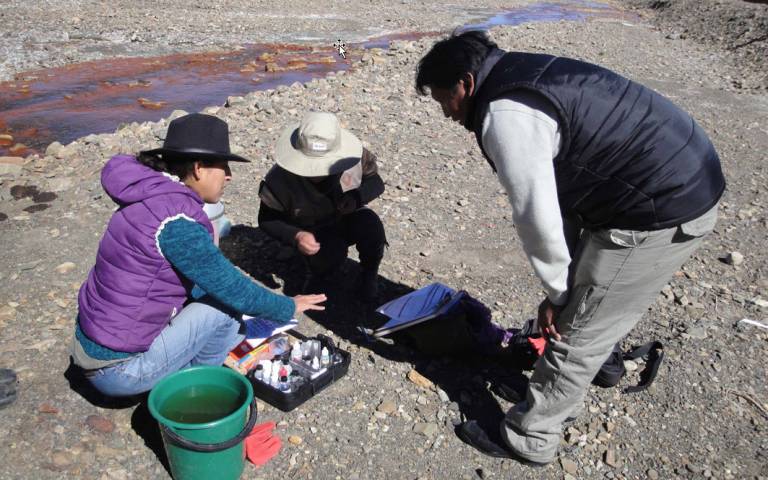Enhancing water quality for indigenous communities near mines in Bolivia
UCL-Birkbeck research on the hazards of mining wastes has resulted in improvements to water resource management in Bolivia and, subsequently, in mining waste risk management in Chile.

12 April 2022
Mining is essential. Unfortunately, mineral processing usually generates a hazardous byproduct of finely ground waste rock and fluid, known as ‘tailings’, which presents risks to the environment and health if it is not properly contained and managed.
Bolivia has many tailings hazard hotspots, because poorly regulated mining activity and tailings disposal over centuries have led to significant contamination of soil and water. One such hotspot lies on the eastern margin of the Altiplano.
Here, water sources and quality in and around mining-affected communities were investigated by a multidisciplinary team from UK and Bolivian universities and non-government organisations (NGOs).
The research was led by Dr Stephen Edwards (UCL Department of Earth Sciences) and included Dr Megan French (formally UCL Institute for Risk and Disaster Reduction) and Professor Karen Hudson-Edwards (formally Birkbeck Department of Earth and Planetary Sciences).
Proving key data for change
Through collaboration with the UCL-Birkbeck researchers, the Bolivian NGO Centro de Comunicación y Desarrollo Andino (CENDA) established indigenous community water management as a core theme and instigated a volunteer-led community water monitoring programme.
Crucially, Dr French’s novel chemical water quality hazard rating demonstrated that only 2% of waters sampled were suitable for direct human consumption and provided critical evidence of the causes and extent of contamination. CENDA published these findings online and submitted them to the Bolivia Vice Ministry of Water Resources and Irrigation, which then committed to additional monitoring through a government programme.
Of the 12,000 indigenous people at risk in the two river basins examined, 200 families have directly benefitted from improved water management and 1,400 indirectly. Community water monitoring has been replicated in other locations in Bolivia that host over 10% of the country’s population.
Sergio Vásquez Rojas, Executive Director of CENDA, said: “Communities now have volunteer water monitors and have been able to self-organise and find their own solutions to the water problem by managing the uses of water according to its quality and availability. This has been greatly aided by the simple UCL tool to assess the hazard presented by each source of water, which is presented as the chemical water quality hazard rating.”
Forging new scientific relationships
The UK government’s showcasing of the project positioned the UK as a key science and innovation partner for Bolivia. It also led to collaboration on tailings risk reduction between UCL, the British Embassy in Chile and the Mining Ministry of Chile.
Through this, UCL developed future disaster scenarios for potential failures of tailings storage facilities, which have been pivotal in Chile developing proposed new national safety and management regulations for its facilities. A further collaboration on retrospectively forecasting a tailings failure in Australia, this time between UCL and the global geoscience technology company CGG, contributed to CGG becoming a market leader in satellite remote sensing across mine sites.
Research synopsis
Building water quality and mining waste risk-reduction capabilities for indigenous communities and government and non-government bodies in Bolivia and Chile
UCL–Birkbeck research on the hazards of mining wastes has resulted in improvements to water resource management in Bolivia and, subsequently, in mining waste risk management in Chile. The work has benefitted indigenous communities, government and non-government bodies, and business, and has enhanced UK international relations in science and innovation.
Links
- Dr Stephen Edward's academic profile
- Professor Karen Hudson-Edwards' academic profile
- Centro de Comunicación y Desarrollo Andino
- UCL Department of Earth Sciences
- UCL Faculty of Maths & Physical Sciences
- UCL Faculty of Maths & Physical Sciences REF 21
Image
- Image credit: Photograph taken by Elisa Guerrero Moreno in Bolivia in 2016.
 Close
Close

